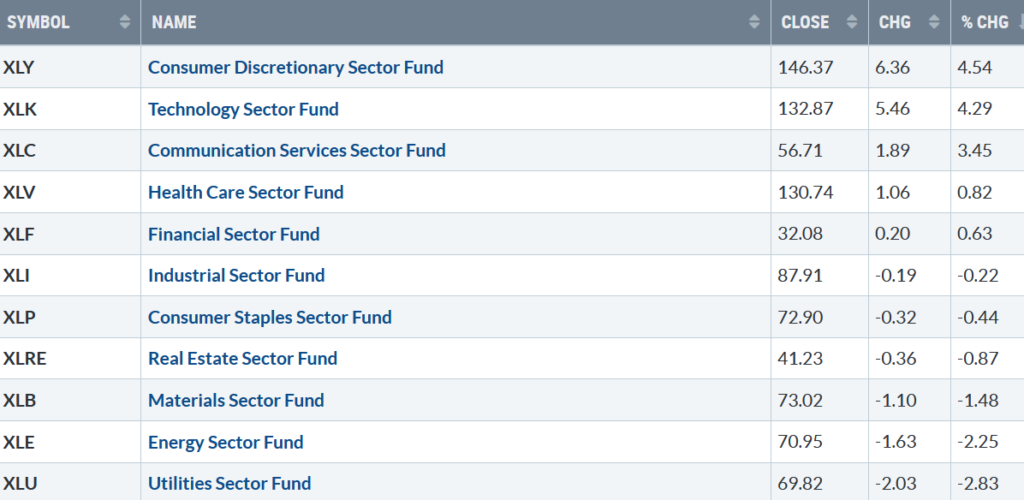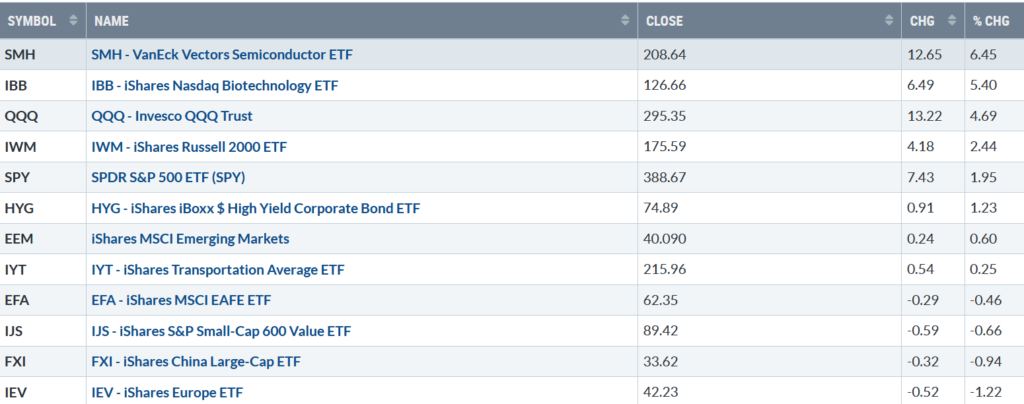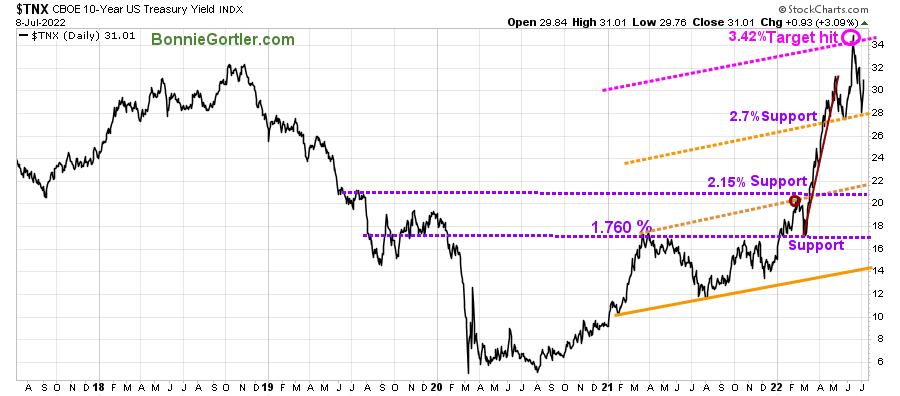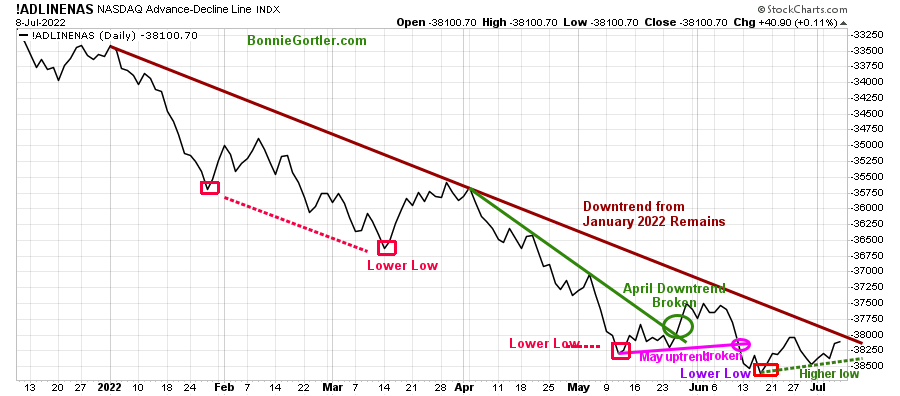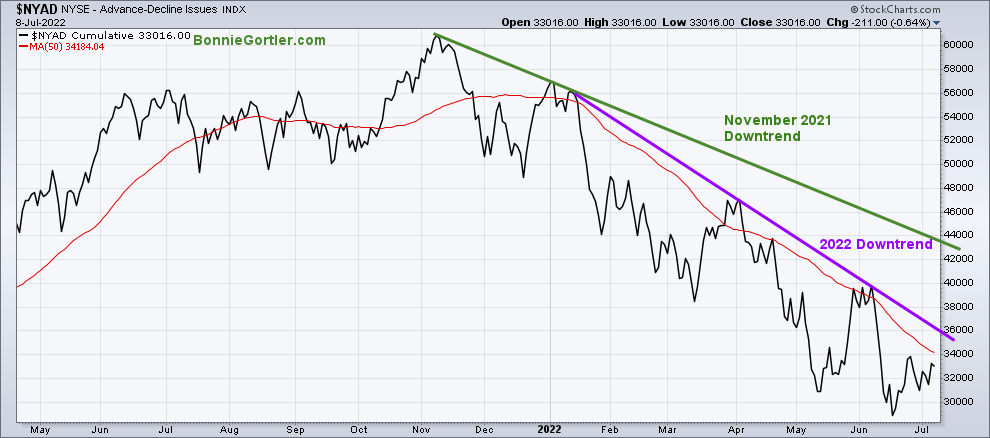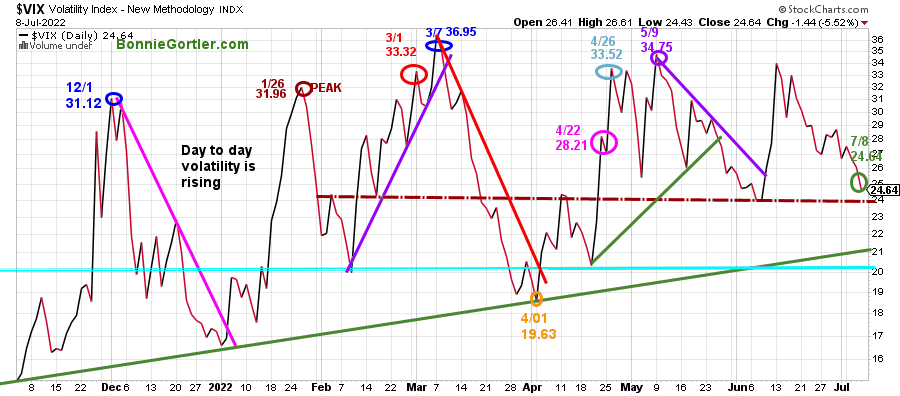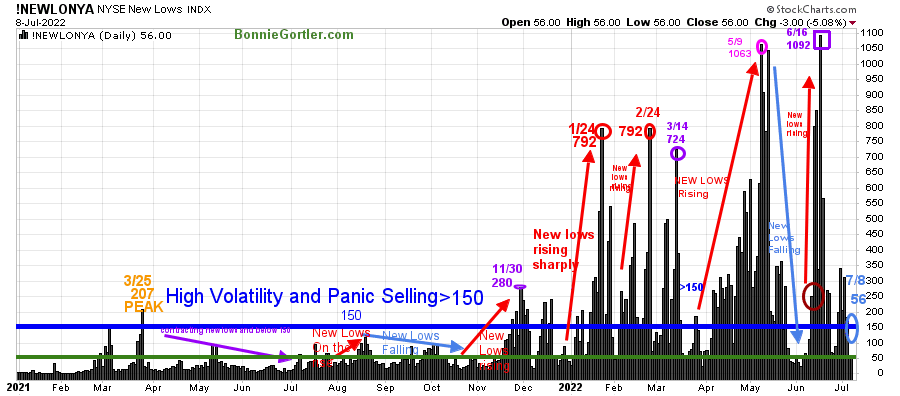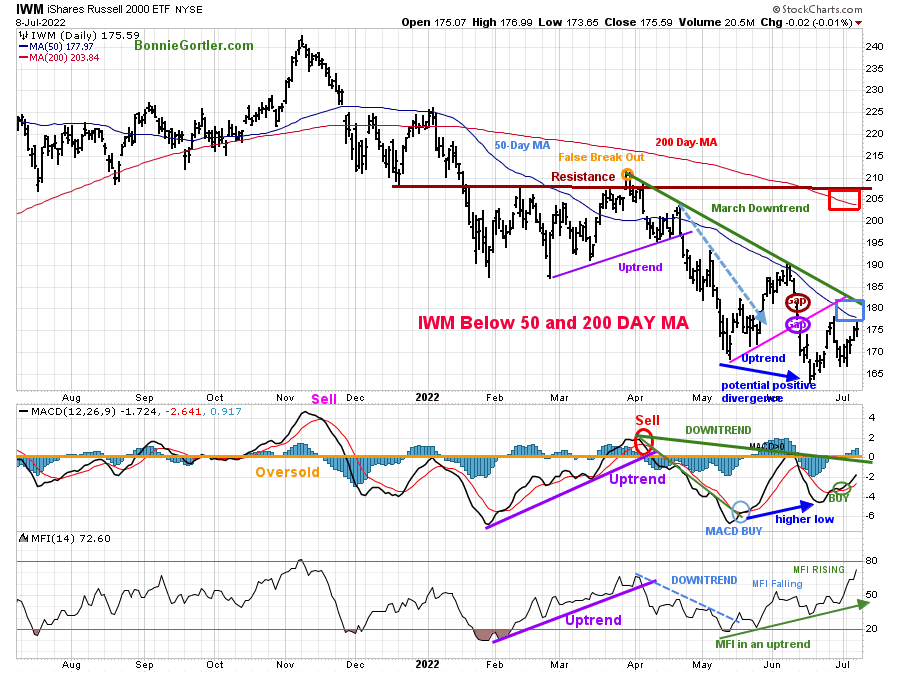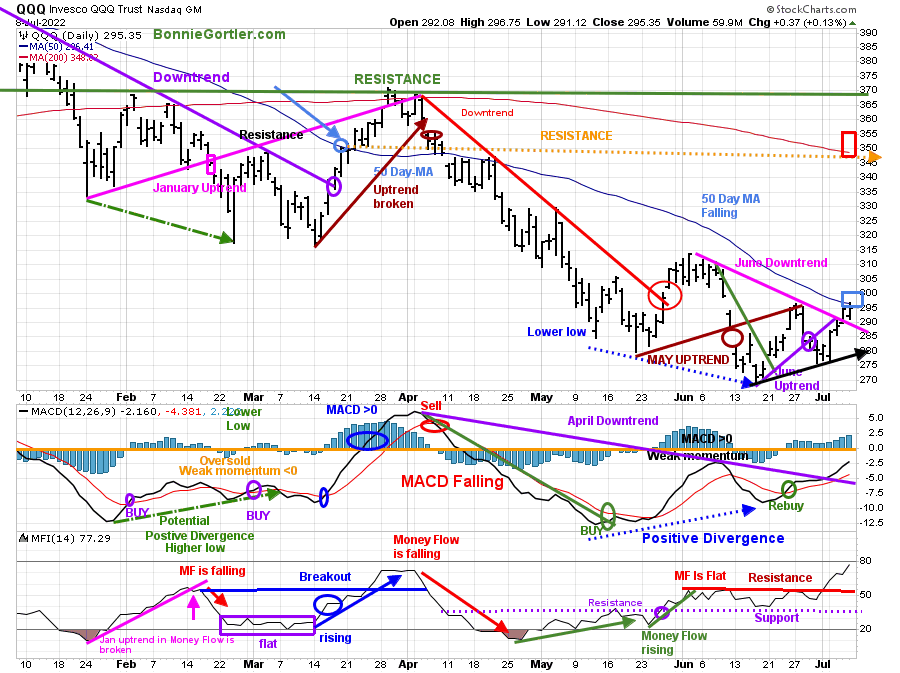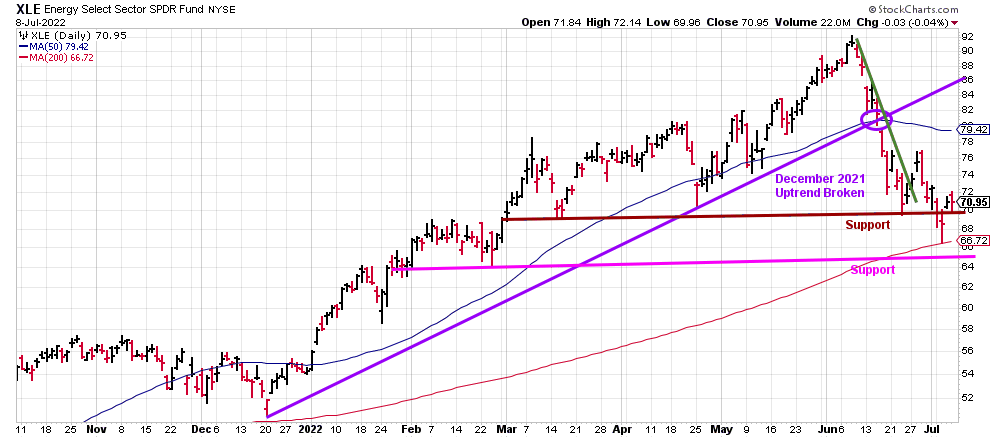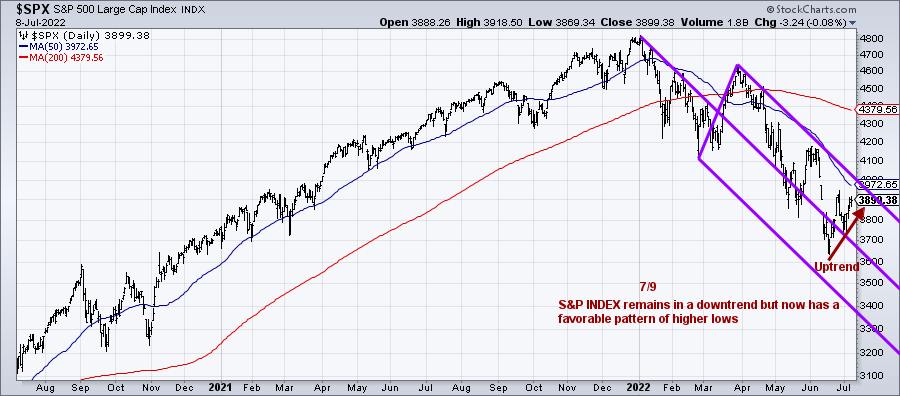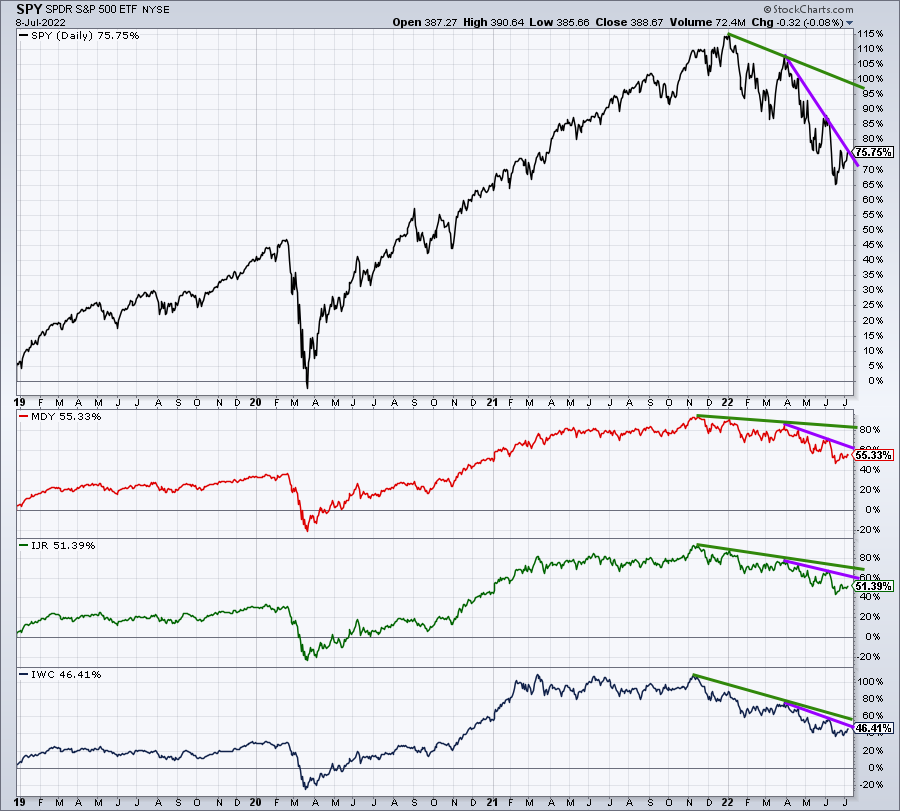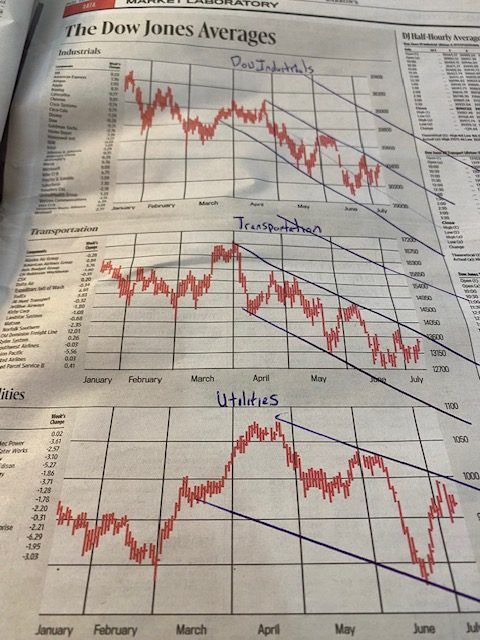Stocks rose as investors were bargain hunting in high-risk sectors that have been down sharply. Five of eleven S&P SPDR sectors were higher last week. Consumer Discretionary (XLY) and Technology (XLK) led while Energy (XLE) and Utilities (XLU lagged, the reverse of the previous week. The SPDR S&P 500 ETF Trust (SPY) rose by +1.95%.
S&P SPDR Sector ETFs Performance Summary
7/01/22 – 7/08/22
Source: Stockcharts.com
Figure 2: Bonnie’s Mix of ETFs
Performance Summary 7/01/22 – 7/08/22
Source: Stockcharts.com
Opposite the previous week, investors were no longer cautious and willing to take on risk. Instead, Semiconductors and Biotechnology led the advance. Technology and Small-Cap Growth showed life as the buyer stepped in and went bargain hunting. However, Emerging Markets showed only small gains, while China and other global markets fell and were weaker than the U.S.
Figure 3: UST 10YR Bond Yields Daily
Source: Stockcharts.com
The 10-Year U.S. Treasury yields increased, closing at 2.976% after hitting support.
The Dow rose +0.77%, S&P 500 gained +1.94%, and the Nasdaq, the leading performer, rose +4.56% on five consecutive up days, its longest winning streak since November 2021. The Russell 2000 Index rose +2.41%, while The Value Line Arithmetic Index (a mix of approximately 1700 stocks was higher by +1.25%.
Weekly market breadth was positive for the New York Stock Exchange Index (NYSE) and Nasdaq. The NYSE had 1895 advances and 1583 declines, with 26 new highs and 439 new lows. There were 3360 advances and 1842 declines on the Nasdaq, with 90 new highs and 734 new lows, once again more new lows than new highs.
Figure 4: Nasdaq Advance-Decline Line (Daily)
Source: Stockcharts.com
The improvement in breadth at the end of May and early June after breaking its April downtrend didn’t last for long, as the Nasdaq weakened.
Last week, Nasdaq had good gains on positive breadth with a slight increase of daily new highs, the most since June. Nothing yet to be excited about, but if this trend of increasing new highs continues, it will be bullish in the short term.
So for a sustainable rally that will last for the intermediate term (weeks to months), more progress and consistency are necessary, including a break of the January 2022 downtrend (brown line).
Figure 5: NYSE Cumulative Advance-Decline Line
Source: Stockcharts.com
The chart above is a breadth indicator representing the cumulative difference between the number of advancing and declining stocks on the New York Stock Exchange (NYSE). Market breadth has continued to be poor since November 2021 (green line).
A positive sign for the overall market’s tone to change from a bearish to a bullish trend is for the 2022 downtrend to be broken (purple line).
Figure 6: CBOE Volatility Index VIX
The CBOE Volatility Index ($VIX), a measure of fear, has been trading above 20.00 for most of 2022. In January, VIX made a high at 31.96 on 1/26 (brown circle), on 3/1 at 33.32 (red circle), and peaked at 36.95 on 3/7 (blue circle).
VIX fell slightly last week, closing at 24.64 (green circle) as the market averages rose.
During the 2022 selloff, we have yet to see panic, where VIX rises above 40.00 or even 60.00, as seen in the past bear market bottoms.
Even though VIX has fallen in the past few weeks, VIX remains relatively high; therefore, day-to-day volatility could continue.
On the other hand, if VIX closes below 24.00, intraday volatility is likely to fall towards the 4/01 April low (orange circle) at 19.63. If you are short-term trading be alert to a turn-up and close above 30.00, which would be considered unfavorable.
. Figure 7: Daily New York Stock Exchange (NYSE) New Lows
Source: Stockcharts.com
Watching New lows on the New York Stock Exchange is a simple technical tool that helps awareness of the immediate trend’s direction.
New lows warned of a potential sharp pullback, high volatility, and “panic selling” for most of 2022, closing above 150. As the market started to move lower in January 2022, New Lows rose sharply, peaking at 792 on 1/24 and again on 2/24 (red circles), implying an increased risk of further selling pressure.
Investors in early May unloaded stocks, and New Lows expanded to 1063 on 5/9 (pink circle), then on 6/16 (purple rectangle), New Lows made a new high of 1092.
Learn more about the significance of New Lows in my book, Journey to Wealth, published on Amazon. Here is an excerpt, when new lows are above 150, the market is negative, higher risk, and selling is taking place. Sometimes it could be severe, and sometimes on a very nasty day, you can have “panic selling,” and big wild swings (high volatility) to the downside may occur. Need a preview? Get a free chapter here.
New Lows shifted out of the high-risk zone, above 150, closing at 56 on 7/8 (light blue circle).
It would be encouraging if News Lows remained below 150 and then remain fall between 25 and 50, indicating lower risk and a confirmation a short-term rally could continue.
On the other hand, it would not be favorable for New Lows to increase to above 150, then I would expect more weakness in the near term.
Figure 8: Daily iShares Russell 2000 (IWM) Price (Top) and 12-26-9 MACD (Middle) and Money Flow (Bottom)
Source: Stockcharts.com
The top portion of the chart is the daily iShares Russell 2000 Index ETF (IWM), the benchmark for small-cap stocks, with a 50-Day Moving Average (MA) (blue line) and 200-Day Moving Average (MA) that traders watch and use to define trends. At the end of March, IWM failed to break out above resistance at 210.00 (orange circle), forming a downtrend (green line).
After IWM fell below support at 183.00, selling accelerated in June, making a new low. IWM closed at 175.59, up +2.44%. The March downtrend remains with IWM closing slightly below the 50 and well below the 200-Day Moving Averages (blue and red rectangle), which is still falling.
Short-term resistance is 180.00 and 183.00. Support is between 165.00 and170.00. Sell stops likely sit below the lows on 6/16 of 162.78, which could fuel more selling and another leg down.
MACD (middle chart) is on a buy. A clear positive divergence formed (one of my favorite patterns). A promising rally occurred last week, although MACD has not yet broken the momentum downtrend from April. For more on MACD divergences, email me at Bonnie@BonnieGortler.com, and I will send you my article MACD Made Simple.
Money Flow (lower chart) broke the April downtrend (dotted blue line) but stalled, but has accelerated higher, to its highest reading since the April peak, implying money is moving into small caps.
Note: There is no weekly in MACD. Support remains at 160.00. Bottom fishing remains risky with the intermediate trend down.
Figure 9: Daily Invesco QQQ Trust (QQQ) Price (Top) and 12-26-9 MACD (Middle) and Money Flow (Bottom)
Source: Stockcharts.com
The chart shows the daily Invesco QQQ, an exchange-traded fund based on the Nasdaq 100 Index. After breaking the March uptrend (brown line) at 355.00, QQQ declined sharply, and at the end of May, the short-term trend turned up after breaking the April downtrend (red line), stalling at 315.00 resistance.
QQQ rose +4.69%, closing at 295.35, one of the leaders in performance last week after being one of the weakest sectors. The June downtrend (pink line) was broken to the upside after breaking below the June uptrend (purple line) but remaining slightly below the down sloping 50-Day MA and below the 200-Day Moving Average (blue and red rectangle).
On a brighter note, QQQ has a pattern of higher lows. Support is at 290.00 and 280.00. Resistance is at 300.00 and 310.00. Sell stops are likely below the lows on 6/16 of 269.28.
Note: a close below would give a downside objective on the weekly chart of 258.00.
The middle chart is MACD (12, 26, 9), a measure of momentum; MACD remains on a buy with a positive divergence. The April downtrend in MACD (purple line)was broken, implying downside momentum is likely to be complete.
Money Flow (lower chart) is rising, penetrating resistance (red line) last week on the rally, at its highest reading since April, fueling higher prices in Nasdaq growth stocks. However, Money flow is in an area where turndowns occur frequently.
Summing up:
Momentum patterns have clearly improved. However, the jury is still out if QQQ will go higher or pull back towards 280.00 and potentially test the 6/16 low at 268.76. Time will tell.
Figure 10: Energy SPDR Daily (XLE)
Source: Stockcharts.com
XLE, the strongest sector of 2022 Energy (XLE), fell below key support at 70.00 last week but held support intra-week above 65.00 (brown line), closing at 70.95 down -2.25%.
Support remains at 65.00 (pink line), with resistance at 76.00, 79.00, and 86.00.
Figure 11: The S&P 500 Index Daily ($SPX)
Source: Stockcharts.com
The S&P 500 (SPX) rose by +1.94%, closing at 3899.38, holding above the middle channel line support at 3700.00. It will be positive if SPX has enough strength to break the upper channel at 4100.00.
Resistance is at 4100.00, followed by 4200.00. Support is at 3800.00 followed by 3700.00. The downside objective is 3400.00
If you are interested in following this chart and other charts during the week, I invite you to join my FB group Wealth Through Market Charts, where I post updated charts intraday.
Figure 12: SPDR S&P 500 ETF Trust (SPY), (Top)
and below SPDR S&P MidCap 400 (MDY), iShares Core S&P Small-Cap (IJR), and iShares Micro-Cap (IWC) ETFs
Source:Stockcharts.com
The daily December 2021 and April 2022 downtrends (green and purple lines) prevail in SPDR S&P 500 ETF Trust (SPY), SPDR S&P MidCap 400 ETF (MDY), iShares Core S&P Small-Cap (IJR), and iShares Micro-Cap (IWC).
Monitor these ETFs closely for a clue the worst is over and time to increase your assets invested.
Figure 13: Barron’s 7/922 The Dow Jones Averages
Source: Barron’s 7/9/22
Above are the Industrials, Transportation, and Utility Dow Jones Averages with trendlines using a ruler and a pen-like I did in 1982. All averages are in a downtrend. When the price closes above the downtrends, it will be easier to make money on the long side.
Summing Up:
All the major averages moved higher with improving momentum patterns. It’s encouraging that short-term support levels held, no new low occurred in the major averages, and now there is a pattern of higher lows. Keep an eye on market breadth to see if new lows contract further and new highs begin to expand on the New York Stock Exchange Index and Nasdaq. Continued strength in growth and small-cap stocks outperforming the S&P 500 would be a favorable sign in the short term. Watch the Nasdaq 100 (QQQ) and Russell 2000 (IWM) for short-term direction this week to see if the bulls continue to buy and squeeze the shorts to cover breaking the existing downtrends.
Remember to manage your risk, and your wealth will grow.
If you liked this article, you will love my Free Grow and Sustain Your Wealth Report. Get it here:
Do you like charts, I invite you to my FB group Wealth Through Market Charts or email me at Bonnie@Bonniegortler.com.
I would love to hear from you. If you have any questions or comments or would like to talk about the market, click here.
Disclaimer: Although the information is made with a sincere effort for accuracy, it is not guaranteed that the information provided is a statement of fact. Nor can we guarantee the results of following any of the recommendations made herein. Readers are encouraged to meet with their own advisors to consider the suitability of investments for their own particular situations and for determination of their own risk levels. Past performance does not guarantee any future results.


